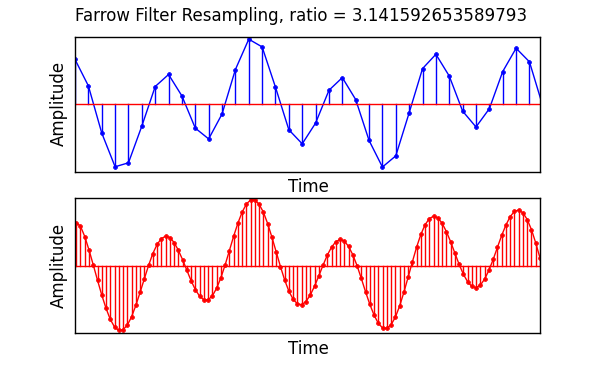Multirate is a package for the creation and execution of streaming (stateful) FIR filters which can also perform sample rate conversion.
Installation
Pkg.add( "Multirate" )Multirate depends on DSP for windowing functions.
Usage
Direct Filtering
These methods allow one-time filter of a vector without the creating of a filter object.
In these examples, x and h are previously defined signal & filter-taps vectors.
using Multirate
# decimate by 3
y = filt( h, x, 1//3 )
# interpolate by 3
y = filt( h, x, 3//3 )
# resample with a ratio of 3/4
# equivalent to interpolating by 3, then decimating by 4
# ( but much more efficient )
y = filt( h, x, 3//4 )Streaming
To use Multirate's streaming filter functionality, you must first create a filter object. Every time you call filt with that object, the filtering processes picks up where it left off. This is good for processing large vectors from a file, or filtering a stream of samples of indefinite length.
Each filter object is of type FIRFilter{Tk<:FIRKernel}. There are four subtypes of FIRKernel:
FIRStandard: normal single-rate FIR filterFIRInterpolator: resampling with a ratio ofL//1FIRDecimator: resampling with a ratio of1//MFIRRational: resampling with a ratio ofL/M
You do not need to specify the kernel type. It is chosen for you when you based on the resampling ratio you specify when creating a new FIRFilter object.
One thing to note is that for decimation and rational resampling, there are instances where filt will return an empty vector. This is because those filters require a certain number of inputs to compute an output. If you call filt and it returns an empty vector, it is working normally, and will eventually return processed samples when it receives enough inputs. However, your code should be written in a way that does not assume that the returned vectors are not empty.
In the following example, we will be resampling with a ratio of 3//17. Please note that the filter taps h in this example is contrived to show you the input to output progression. It performs no useful signal filtering.
julia> x = [ 1.0:100 ]
100-element Array{Float64,1}:
1.0
2.0
3.0
4.0
5.0
6.0
⋮
95.0
96.0
97.0
98.0
99.0
100.0
julia> h = [ ones(3), zeros(6) ]
9-element Array{Float64,1}:
1.0
1.0
1.0
0.0
0.0
0.0
0.0
0.0
0.0
julia> myfilt = FIRFilter( h, 3//17 )
FIRFilter{FIRRational}(FIRRational(3x3 Array{Float64,2}:
0.0 0.0 0.0
0.0 0.0 0.0
1.0 1.0 1.0,3//17,3,3,0,1,1),[0.0,0.0],2)
julia> y1 = filt( myfilt, x[1:5] )
1-element Array{Float64,1}:
1.0
julia> y2 = filt( myfilt, x[6:23] )
4-element Array{Float64,1}:
6.0
12.0
18.0
23.0
julia> y3 = filt( myfilt, x[24:100] )
13-element Array{Float64,1}:
29.0
35.0
40.0
46.0
52.0
57.0
63.0
69.0
74.0
80.0
86.0
91.0
97.0
julia> y = [ y1, y2, y3 ]
18-element Array{Float64,1}:
1.0
6.0
12.0
18.0
23.0
29.0
⋮
69.0
74.0
80.0
86.0
91.0
97.0
Let's check that y, created by filtering three separate chunks of x, matches the result we would obtain from stateless filtering.
julia> sum( y .- filt( h, x, 3//17 ) )
0.0
Speed
The naive approach to resampling is a two to three step process, depending on whether you are decimating, interpolating, or both in case of rational resampling. For a rational factor, the processes look like:
- Stuff
L-1zeros between each input sample. - Apply your anti-alias filter. This fills in those zeros from step 1.
- Keep one out of
Msamples from step 2, and throw away the rest.
Let's design a naive rational resampler:
function naiveresampler{T}( h::Vector{T}, x::Vector{T}, ratio::Rational{Int} )
upfactor = num( ratio )
downfactor = den( ratio )
xStuffed = zeros( T, length(x) * upfactor )
for n in 0:length(x)-1
xStuffed[ n*upfactor+1 ] = x[ n+1 ]
end
yInterpolated = DSP.firfilt( h, xStuffed )
y = [ yInterpolated[n] for n = 1:downfactor:length( yInterpolated ) ]
endand define some input samples:
# resample from 48 kHz to 44.1 kHz
sampleRate = 48000
interpolation = 147
decimation = 160
ratio = interpolation//decimation
numTaps = 24*interpolation # that's a lot of taps
x = rand( Float32, 1_000_000 )
h = Multirate.firdes( numTaps, 0.5/interpolation, Multirate.kaiser, beta = 7.8562 )Now let's time naiveresampler and Multirate.filt:
julia> @time y = naiveresampler( h, x, 147//160 );
elapsed time: **3.713267311 seconds** (**2361632424** bytes allocated, 5.05% gc time)
julia> resampler = Multirate.FIRFilter( h, ratio );
julia> @time y = Multirate.filt( resampler, x );
elapsed time: **0.056938961 seconds** (**7350144** bytes allocated)
The difference in speed is huge, but not necessarily surprising. Perhaps the most surprising part of this demo is the memory allocation. naiveresampler allocated almost 2.4 GB vs Multirate.filt's 7.4 MB.
Multirate is not heavily optimized numerically speaking, and has much room for improvement, but by using polyphase FIR implementation it is able to only do math on the samples that are kept. It doesn't waste cycles multiplying taps by stuffed zeros, and it does not do any multiplications on samples that are thrown out in the decimation process. Despite this, it produces results identical to the naive approach.
One way the code is optimized is that the filter-taps/polyphase-filter-banks are flipped in memory. Many filter routines found on the internet use the literal definition of discrete convolution by moving forward in memory through the input samples, and backwards in memory through the filter taps, or vice versa. Having the coefficients flipped is more friendly to the compiler. In some cases the compiler will emit SIMD instructions to perform multiple multiplications at a time.

